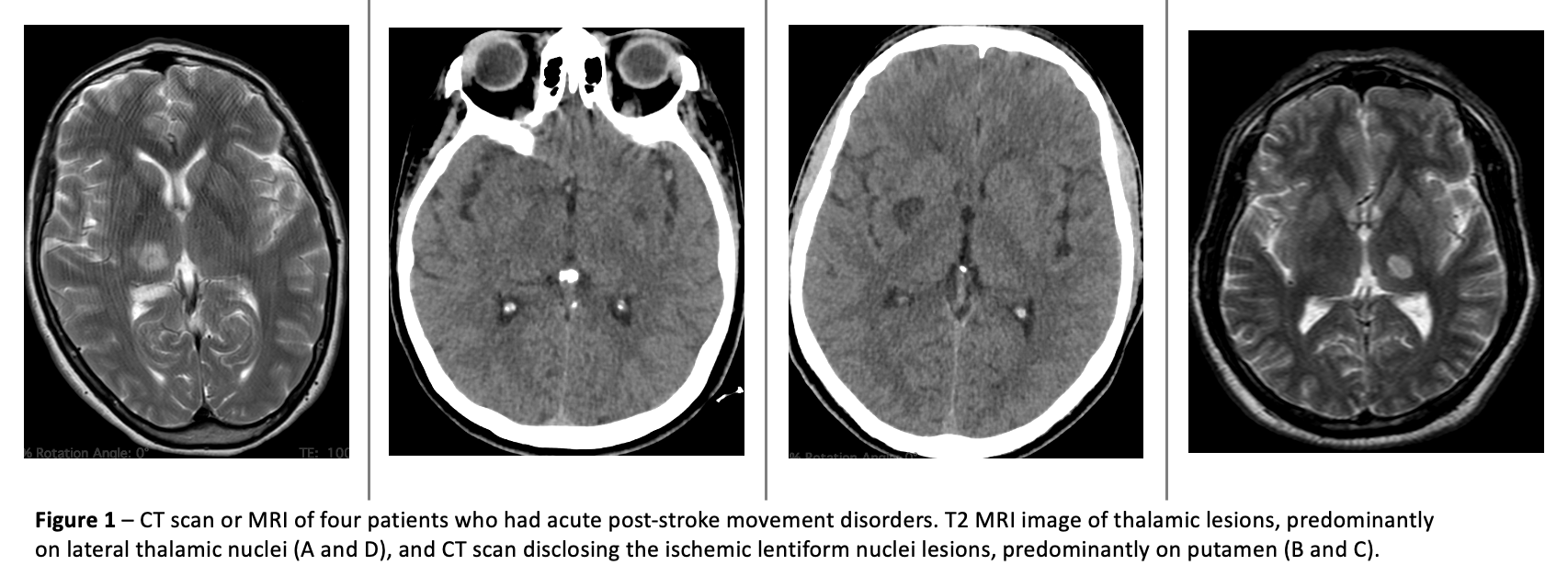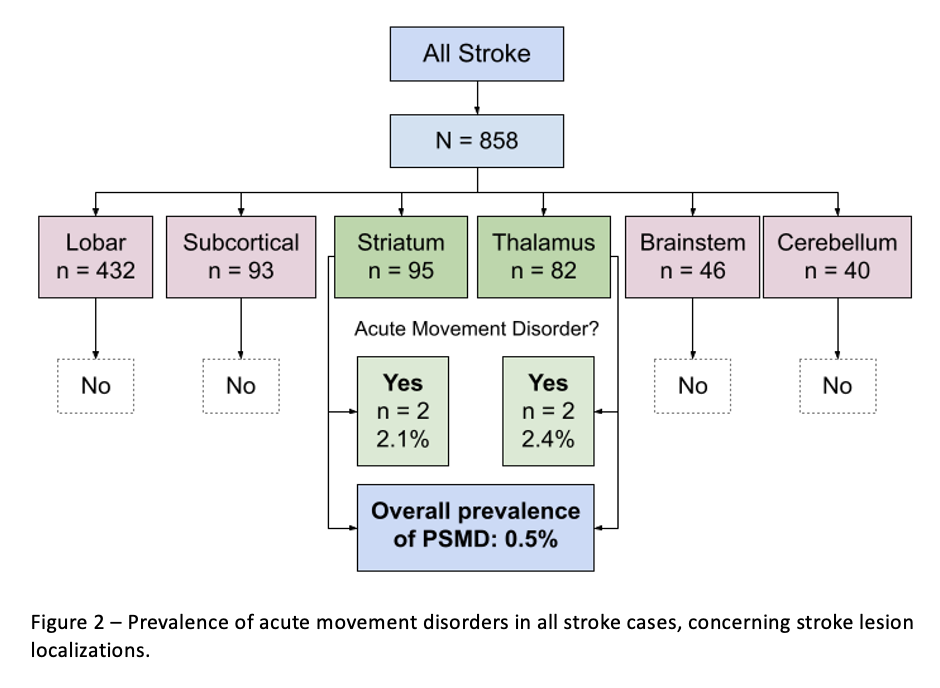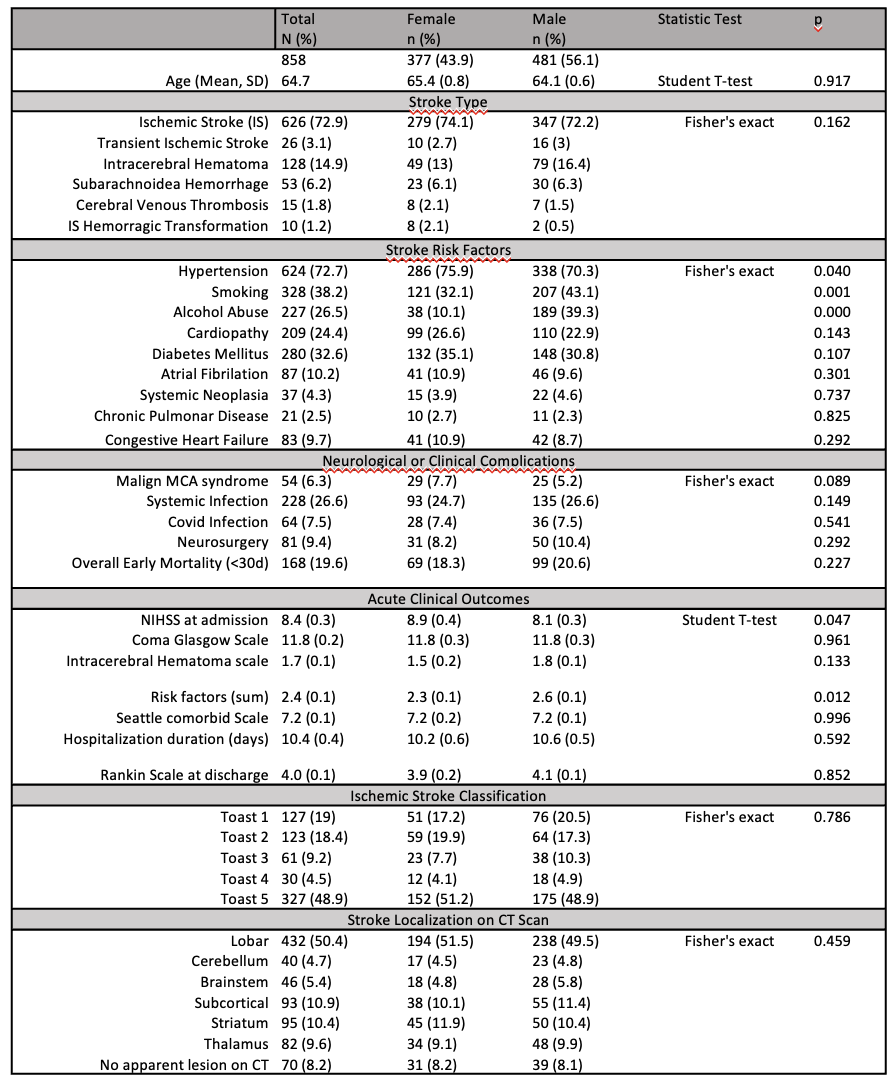Category: Epidemiology
Objective: To ascertain the prevalence of acute post-stroke movement disorders (PSMD) in a prospective cohort of acute stroke patients.
Background: Post-stroke movement disorders can occur either acutely or in the first year following a stroke. Abnormal movements after a stroke may be either hypo or hyperkinetic, but involuntary hyperkinetic movements are more frequently observed during stroke follow-up [1]. PSMD is uncommon, with a known prevalence of about 1% and an incidence of 0.08% per year, highlighting the rarity of PSMD [2]. Most basal ganglia and thalamic lesions did not result in movement disorders, suggesting that stroke location may not predict PSMD [2]. Also, PSMD may be associated with both ischemic and hemorrhagic strokes [3]. Few studies concern PSMD prevalence in a designed prospective cohort.
Method: We designed an open, prospective, one-year, single-center stroke cohort to follow all acute stroke searching for movement disorders during hospitalization and after discharge. PSMD was the primary outcome, and death was the main competitive outcome. Our study included all acute stroke patients admitted to the hospital from March 2021 to February 2022. data, We captured demographic, clinical, and neurological data (Table1) such as NIH stroke scale, mRankin scale, Glasgow coma scale, and abnormal involuntary movement scale. We also evaluated the first CT scan of all patients for stroke localization and type determinations.
Results: We included 858 acute stroke patients. There were four acute PSMD patients in this cohort, yielding a prevalence of 0.5%. In all PSMD cases, the stroke was ischemic. Two patients revealed thalamic lesions (2.4% of thalamic stroke patients), and two had striatal ischemic strokes (2.1% of striatal stroke patients) (Figures 1-2). Movement disorder occurred in the first 24h after ischemia in all cases. Concerning the abnormal movement phenotype, all were hyperkinetic. One case disclosed acute tremor after striatal ischemia, and in the other patients, dystonia was the prevalent movement disorder. Only one dystonic patient (lentiform lesion) persisted with abnormal movement after 90 days of stroke.
Conclusion: This large cohort confirms that PSMD in acute stroke is rare, with an established prevalence of 0.5% for all stroke events. PSMD was associated with striatal and thalamic ischemic stroke, and all cases presented acute hyperkinetic movement disorder.
References: 1. Nakawah MO, Lai EC: Post-stroke dyskinesias. Neuropsychiatr Dis Treat. 2016, 12:2885-93. DOI – 10.2147/NDT.S118347
2. Ghika-Schmid F, Ghika J, Regli F, Bogousslavsky J: Hyperkinetic movement disorders during and after acute stroke: the Lausanne Stroke Registry. J Neurol Sci. 1997, 146:109-16. 10.1016/s0022-510x(96)00290-0
3. Alarcón F, Zijlmans JC, Dueñas G, Cevallos N: Post-stroke movement disorders: report of 56 patients. J Neurol Neurosurg Psychiatry. 2004, 75:1568-74. 10.1136/jnnp.2003.011874
To cite this abstract in AMA style:
MS. Rocha, L. Alves, J. Tatsch, H. Bezerra, J. Freitas, I. Torres, J. de Paula, P. Marques, P. Matos. Prevalence of Movement Disorders After Acute Stroke: a Large Prospective Cohort Stroke Study [abstract]. Mov Disord. 2022; 37 (suppl 2). https://www.mdsabstracts.org/abstract/prevalence-of-movement-disorders-after-acute-stroke-a-large-prospective-cohort-stroke-study/. Accessed April 21, 2025.« Back to 2022 International Congress
MDS Abstracts - https://www.mdsabstracts.org/abstract/prevalence-of-movement-disorders-after-acute-stroke-a-large-prospective-cohort-stroke-study/



